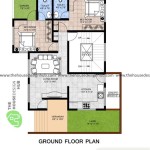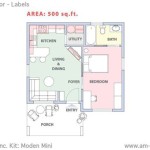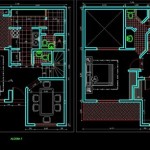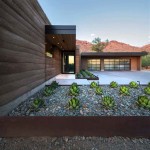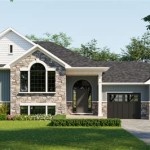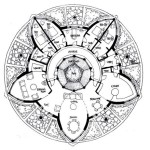Passive House Design Floor Plan: Optimizing for Energy Efficiency
Passive House design represents a rigorous, voluntary standard for energy efficiency in a building, resulting in ultra-low energy consumption while maintaining superior indoor air quality and thermal comfort. A crucial element in achieving this standard lies in the meticulous planning and execution of the floor plan. The Passive House floor plan is not merely a layout of rooms; it's a strategically designed map for energy performance.
The core principles of Passive House design – airtight construction, continuous insulation, high-performance windows, thermal bridge-free design, and heat recovery ventilation – are all deeply intertwined with the floor plan. The placement of rooms, windows, and walls influences the building's interaction with the sun, wind, and surrounding environment. Therefore, the floor plan serves as the foundation for optimizing these interactions and maximizing energy efficiency.
One of the primary considerations in a Passive House floor plan is solar orientation. Ideally, living spaces and rooms requiring the most heat are positioned on the south side of the building (in the northern hemisphere) to maximize solar gain during the winter months. This passive heating strategy reduces the need for active heating systems. Conversely, service areas, utility rooms, and storage spaces are typically located on the north side to act as a buffer against colder winds and minimize heat loss.
Window placement is another critical aspect of Passive House floor plan design. Strategically positioned windows allow for natural daylighting, reducing the need for artificial lighting. South-facing windows, in particular, capture solar heat during the winter. However, careful consideration must be given to window size and shading to prevent overheating during the summer months. Overhangs, external shutters, and deciduous trees can be incorporated into the design to provide seasonal shading.
The building’s form factor, influenced by the floor plan, plays a significant role in energy efficiency. A compact building shape minimizes the surface area exposed to the outside, reducing heat loss. Simple rectangular or square floor plans are generally more efficient than complex shapes with numerous projections and recesses, which increase the surface area and can create thermal bridges.
Thermal bridging, the phenomenon of heat transfer through building elements with higher thermal conductivity, is a major concern in Passive House design. The floor plan must be carefully designed to minimize thermal bridges. Continuous insulation, applied seamlessly across the entire building envelope, is crucial. The floor plan should facilitate this continuous insulation layer without interruptions, ensuring consistent thermal performance.
Airtightness is another fundamental principle of Passive House design. A well-sealed building envelope prevents unwanted air leakage, which can lead to significant energy loss. The floor plan should be designed to simplify the airtight layer installation and minimize potential leakage points. Careful detailing around windows, doors, and other penetrations is essential.
The integration of a heat recovery ventilation (HRV) system is a crucial element in Passive House design. The HRV system continuously supplies fresh, filtered air while recovering heat from the outgoing stale air. The floor plan should accommodate the ductwork for the HRV system, ensuring efficient air distribution throughout the building. The placement of air inlets and outlets requires careful planning to avoid drafts and ensure optimal ventilation effectiveness.
The design process for a Passive House floor plan often involves energy modeling software. These tools allow architects and designers to simulate the building's energy performance based on the floor plan, window placement, insulation levels, and other factors. This allows for optimization of the design to achieve the stringent Passive House energy targets.
Creating a Passive House floor plan requires a holistic approach, considering all aspects of building performance from the outset. It’s not simply about arranging rooms but about optimizing the interaction between the building, its occupants, and the environment. This integrated design approach results in a comfortable, healthy, and ultra-energy-efficient building.
The successful execution of a Passive House relies heavily on the careful planning of the floor plan. By prioritizing solar orientation, optimizing window placement, minimizing thermal bridging, ensuring airtightness, and integrating a heat recovery ventilation system, a Passive House floor plan sets the stage for achieving the remarkable energy efficiency targets that define this standard.
Furthermore, incorporating these design principles into the floor plan from the beginning streamlines the construction process and reduces the risk of costly retrofits. The Passive House floor plan is an investment in long-term energy savings, occupant comfort, and environmental sustainability.

Heatspring Free Floor Plan 10 Ways Passive House Design Is Diffe Than Normal Home

Deltec Homes Renew Collection Ridgeline B 1604sf Passive Solar Layout Vaulted Ceilings High Clere House Plans Prefabricated Houses Dream

Passive Solar Home Plan At Alternative Heating Com House Design Homes Plans

Floor Plan Friday Passive House Design

Passive Solar House Plan 2 Bedrms Baths 1418 Sq Ft 146 2710

Solar Adobe House Plan 1870
What Does A Passive House Cost To Build Leanhaus

Passive Solar House Plans For Our Off Grid Homestead Byexample Com

Green Passive Solar House Plans 3

Great Floor Plan For Solar Passive Home In Google Search House Plans Narrow

